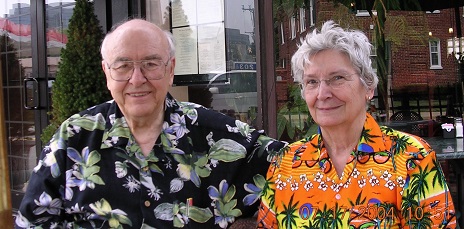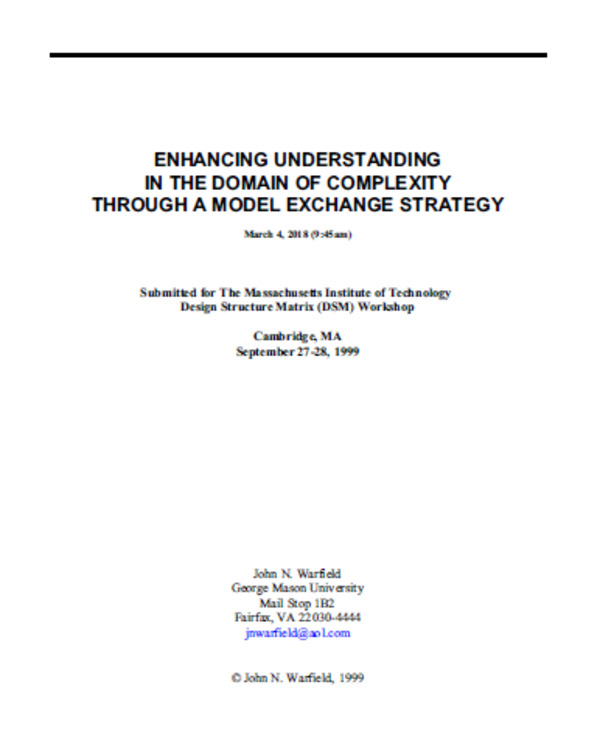Sent to GMU 27 September 2007 (but it was already there in box 21, folder 35).
ABSTRACT written by the author: "Practitioners often propose individual model types that they find useful, which offer applicability across various arenas. In the domain of complexity, it has been found that there is no single type of model that is satisfactory in the light of the onerous demands that must be satisfied to achieve broad applicability. In view of that, a strategy of model exchange was developed two decades ago, and has been under continuous testing and upgrading since that time. A matrix model type can be a part of any model exchange strategy that is applied in the domain of complexity. Overall effectiveness must take into account factors that are not well-treated exclusively by matrix models. Some of the other types that (also) have limited, but valuable, utility include: algebraic models, prose models, various ill-defined graphical models (often understood only by very small practitioner sets), and prose-graphic structural models. The most valuable model exchange strategy involves a consideration of such thoughts as: (A) How can one transform a given model into another format? (B) What are the advantages and disadvantages of particular formats? (C) How can model performance be assessed in particular formats? (D) How many distinct formats, taken as a set, should be a part of a model exchange strategy? (E) How can one balance best the interactive components, e.g., human-computer interactions? (F) What concessions must be made for broad human understanding when non-specialists are involved? One such model exchange strategy is discussed, and various instances of its successful application will be described. Further references are provided."
Notes: The manuscript consists of 13 typewritten pages of text with the rest of it being printouts of transparencies used in the talk. This manuscript was prepared in response to an invitation received on 30 June 1999 from Dr. Ali Yassine (yassine@mit.edu), to “participate in the Design Structure Matrix (DSM) Research Workshop we will be hosting at MIT on 27-28 September 1999.” Two other persons were also on the hosting committee: Prof. Steven Eppinger (eppinger@mit.edu) and Dr. Daniel Whitney (dwhitney@mit.edu). Warfield had great hopes that his work would receive a good reception at this conference, especially from Dr. Whitney who was doing consulting work for Ford. Alas, nothing came of the speech, except the suspicion that much of the information he gave in this talk was picked up and used without attribution in the projects of other people. The paper was not published in any proceedings that I can locate, and I hunted good and long with Google Search. It wasn't even mentioned as being RECEIVED at the conference, although he certainly made the presentation. (R.w. 12 Sept 2013)
NOTE: THERE ARE THREE POWERPOINT SLIDES SHOW DATED 2007, WHICH DEAL WITH THIS TALK, THEY ARE MTU POWERPOINTS NUMBER mtu21, 22, 23. and filename "MIT modex PRES."
TITLES OF TRANSPARENCIES Used in MIT TALK in 1999 Sloan School, Workshop on Design Structure Matrix SEPTEMBER 28, 1999, Cambridge Massachusetts:
A. Structure of the Work Plan for Understanding and Resolving Complexity cel208;
STRIVING FOR SENSITIVITY TO COGNITIVE LIMITATIONS AND DIFFERENCES AMONG AUDIENCES
B-Friedman Quotation #1: Reasons for Failures, cel239; C. Friedman Quotation #2: Reasons for Defective Models, cel240; D. Why Matrices are Valuable to Engineers, cel247; E. Limitations of Matrices, cel248; F. Possible Model Exchanges, cel249; G. The Theorem of Non-Conservation of Consistency, ce1250; H. The Theorem of Assured Consistency, cel251;
SPREADTHINK DATA
I. Individual Voting Patterns on Relative Importance of Problems (Ford Data), caw024; J.Distribution of Votes Across Problems (Ford Data), ce1203; K. Explaining the "Japanese Miracle"-1 (Litzelman Data, Number of Mentions of Explanatory Factors), cel237; L. Explaining the "Japanese Miracle"-2 (Litzelman Data, Number of Authors who Cited the Number of Factors Shown), cel238;
BELIEFS ABOUT KILLER ASSUMPTIONS (Perino Data)
M. Seven Major Discrepancies Between Manager/Faculty Beliefs, cel246; N. Assumptions that NO Faculty Believe, cel241; O. Three Assumptions with Major Manager/Faculty Discrepancies, cel242; P. Assumptions About Infrastructure Needed to Resolve Complexity, cel243; Q. Assumptions With Low Percentages, but Near Manager/Faculty Agreement, cel244; R. Assumptions with Strong Manager/Faculty Support, cel245; S. The Observatorium, cow088.
r.w. circa 2000


